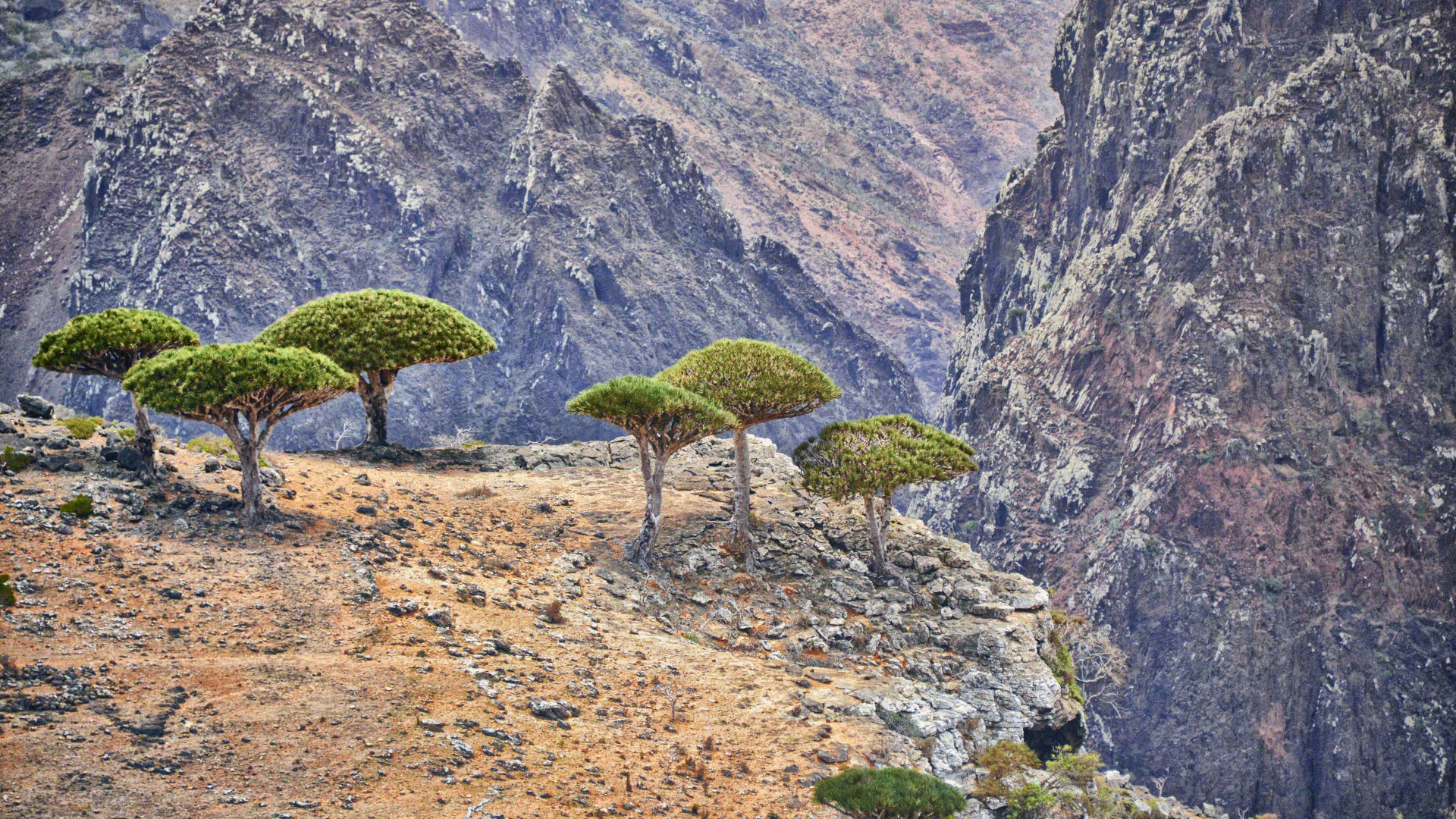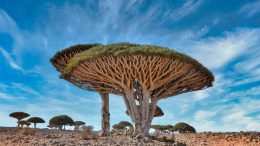Dragon’s blood trees (Dracaena cinnabari) are evolutionary marvels of the plant kingdom, but they may not be around forever.
Native to a single island in the Socotra archipelago, off the coast of Yemen in the Arabian Sea, the extraordinary-looking dragon’s blood tree, which is classified as “vulnerable to extinction,” can grow to more than 30 feet in height and live for 600 years. Looming over the island’s rocky, mountainous terrain, it produces rich berries and a vermilion sap — the source of its name — that has been used for centuries as everything from medicine to lipstick, and even as a varnish for violins.
Visually, the trees are stunning. Their branches grow in an outward-forking pattern that gives them the look of a giant mushroom or an umbrella sucked inside-out by the wind.
 And that appearance isn’t the only umbrella-like aspect of the dragon’s blood. New research, published in the journal Forests, suggest the tree could also be considered an umbrella species — the protection of which would benefit a wide range of other species.
And that appearance isn’t the only umbrella-like aspect of the dragon’s blood. New research, published in the journal Forests, suggest the tree could also be considered an umbrella species — the protection of which would benefit a wide range of other species.
The umbrella species concept has traditionally been applied to large, wide-ranging, charismatic mammals and birds such as giant pandas, mountain gorillas and northern spotted owls. The theory is that by protecting these animals and their habitats you also, directly or indirectly, conserve everything else that lives near them.
A team of researchers from Socotra, Spain and Portugal wanted to find out if the dragon’s blood tree could do the same thing — even though, unlike other umbrella species, it stays in one place. It’s not that big a leap: The tree has long been considered an indicator species, meaning it quickly shows signs of changes to its environment and plays host to a wide range of the island’s other unique wildlife. But would protecting the dragon’s blood also help other species?
The researchers studied 280 trees for two months and found that they provided food and shelter to at least 12 of Socotra’s endemic reptile species, including 10 geckos, one chameleon and a snake. Some of these species were only observed a few times, so they probably don’t fully depend on the dragon’s blood, but others, like the critically endangered gecko known only as Hemidactylus dracaenacolus, appear to only live amidst the trees.

The trees themselves weren’t the only part of the equation. Bushes from the Cissus genus grow near and around the trees, providing a shared habitat for many of the observed lizards.
Although the researchers caution that their research period was relatively short, they say this supports their hypothesis that the dragon’s blood tree should be considered an umbrella species on the Socotra archipelago and protected for the good of the whole.
And that protection is sorely needed. Dragon’s blood trees face a wide range of threats, including logging, habitat fragmentation, and overgrazing of seeds and young shoots by livestock. Few new trees survive to maturity. The trees currently occupy just 10% of their potential habitat.
Climate change will make things even worse. The island is already getting drier, and research cited in the Forests paper calculates the dragon’s blood will lose up to 45% of its remaining range by the year 2080.
As the researchers write, this means dragon’s blood forests are in urgent need of protection now.
But Yemen remains in the grips of a five-year war that includes a power struggle for control of Socotra. This conflict, which has killed more than 100,000 people, has curtailed conservation efforts on the island. The researchers, who conducted their study before the conflicts began, note that international funding to help nurseries grow dragon’s blood seedlings has been placed “on hold due to the country’s political situation.” (Saudi Arabia just announced two-week cease-fire, which was expected to begin on April 9 amidst the COVID-19 pandemic.)
For now the dragon’s blood tree persists, and its umbrella-like branches continue to serve as vital shelter and resource for the both the human and ecological communities around them.
Watch this 2014 video about the dragon’s blood tree and the threats it faces from climate change:
![]()


